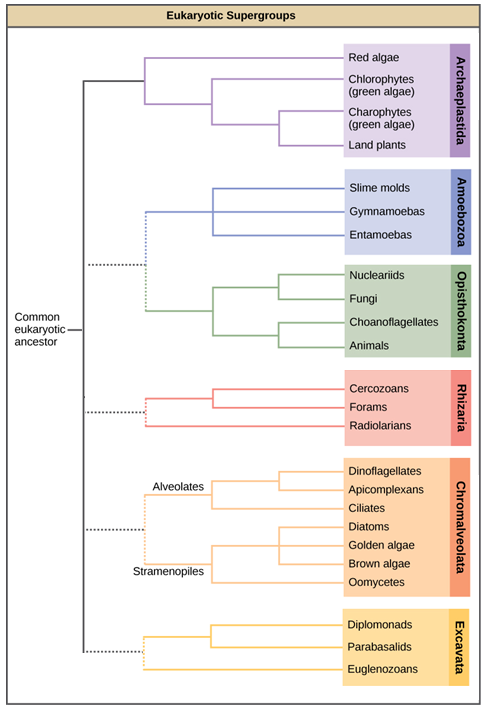Classify protists into unique categories
In the span of several decades, the Kingdom Protista has been disassembled because sequence analyses have revealed new genetic (and therefore evolutionary) relationships among these eukaryotes. Moreover, protists that exhibit similar morphological features may have evolved analogous structures because of similar selective pressures—rather than because of recent common ancestry. This phenomenon, called convergent evolution, is one reason why protist classification is so challenging. The emerging classification scheme groups the entire domain Eukarya into six “supergroups” that contain all of the protists as well as animals, plants, and fungi that evolved from a common ancestor (Figure 1). Each of the supergroups is believed to be monophyletic, meaning that all organisms within each supergroup are believed to have evolved from a single common ancestor, and thus all members are most closely related to each other than to organisms outside that group. There is still evidence lacking for the monophyly of some groups. Each supergroup can be viewed as representing one of many variants on eukaryotic cell structure. In each group, one or more of the defining characters of the eukaryotic cell—the nucleus, the cytoskeleton, and the endosymbiotic organelles—may have diverged from the “typical” pattern.

Figure 1. Eukaryotic supergroups. This diagram shows a proposed classification of the domain Eukarya. Currently, the domain Eukarya is divided into six supergroups. Within each supergroup are multiple kingdoms. Although each supergroup is believed to be monophyletic, the dotted lines suggest evolutionary relationships among the supergroups that continue to be debated.
Keep in mind that the classification scheme presented here represents just one of several hypotheses, and the true evolutionary relationships are still to be determined. The six supergroups may be modified or replaced by a more appropriate hierarchy as genetic, morphological, and ecological data accumulate. When learning about protists, it is helpful to focus less on the nomenclature and more on the commonalities and differences that illustrate how each group has exploited the possibilities of eukaryotic life.
What You’ll Learn to Do
- Identify characteristics and examples of protists in the supergroup Excavata
- Identify characteristics and examples of protists in the supergroup Chromalveolata
- Identify characteristics and examples of protists in the supergroup Rhizaria
- Identify characteristics and examples of protists in the supergroup Archaeplastida
- Identify characteristics and examples of protists in the supergroup Amoebozoa
- Identify characteristics and examples of protists in the supergroup Opisthokonta
Learning Activities
The learning activities for this section include the following:
- Excavata
- Chromalveolata
- Rhizaria
- Archaeplastida
- Amoebozoa
- Opisthokonta
- Self Check: Groups of Protists
Candela Citations
- Introduction to Groups of Protists. Authored by: Shelli Carter and Lumen Learning. Provided by: Lumen Learning. License: CC BY: Attribution
- Biology 2e. Provided by: OpenStax. Located at: http://cnx.org/contents/185cbf87-c72e-48f5-b51e-f14f21b5eabd@10.8. License: CC BY: Attribution. License Terms: Access for free at https://openstax.org/books/biology-2e/pages/1-introduction
